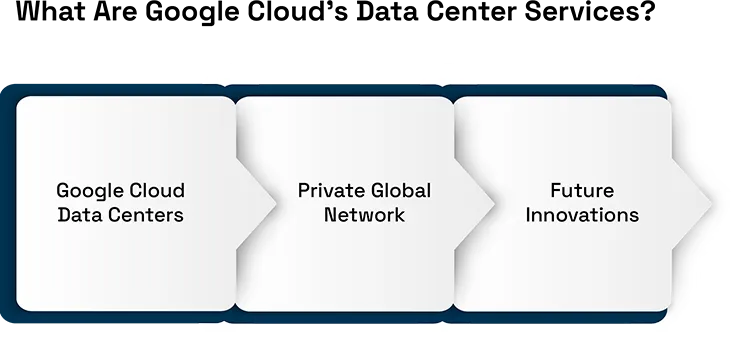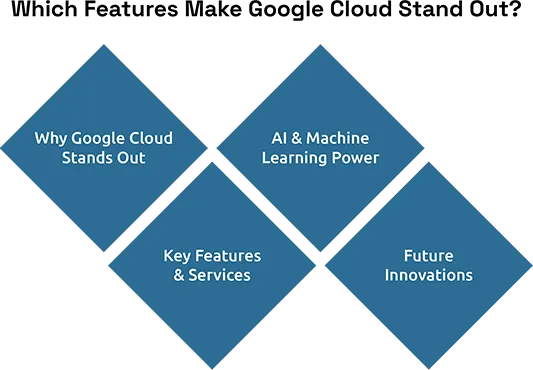Google Cloud’s data center services will likely become essential for enterprises of all types to support their global infrastructure to be agile, innovative, and green. One is the revelation of the Axion chip, which is Google’s first in-house ARM-based CPU built for its data centers to boost the two segments, performance and energy efficiency. Moreover, with the launch of Gemini 1.5 Pro, an enhanced AI mode, new potential in fields like cybersecurity, post-production, and diagnosis has emerged, helping various companies to adopt innovative solutions for their practices.
Google Cloud’s commitment to global expansion is evident in its substantial investments in new data centers, including a $2 billion facility in Fort Wayne, Indiana, expected to create approximately 200 jobs. Furthermore, Google Cloud’s emphasis on sustainability is reflected in its carbon-neutral operations and tools like the Carbon Footprint tracker, allowing businesses to monitor and reduce their environmental impact. -These advancements position Google Cloud as a strategic partner for businesses seeking robust, innovative, and eco-friendly data center services in 2025.
What Are Google Cloud’s Data Center Services?
Google Cloud Data Center services largely include a set of cloud computing products provided by Google through its data centers for businesses to store, process, and manage their data. These primary services include the computing services, storage services, and networking services offered through Google’s data centers located across the geographical environment. Using these services, companies can use superior technology that they could not afford to integrate through hardware devices.
As such, these services can be best described as flexible and easily adaptable to the various needs ranging from startups to big firms. It is suitable to support many other applications, ranging from simple website hosting to data analysis and machine learning computations. This explains why the use of outsourcing services is so popular; it allows for rapid incorporation of such changes.

Why Businesses Are Turning to Google Cloud
Because businesses rely on Google Cloud’s fast development infrastructure for uptime and dependability, the service is gaining popularity. Google has many data centers that allow organizations to deploy their applications closer to users, which means that organizations can achieve low latency and optimized high computing performance. Top data center Organizations looking to lessen their carbon footprint are also attracted to Google Cloud because of its sustainability initiatives.
The blending of other new high-tech technologies with artificial intelligence (AI) and machine learning (ML) is also a strong persuasive factor. Organizations can leverage their Google Cloud services to utilize AI and ML in order to gain insights and give automation, enabling improved decision-making and operational efficiencies. These capabilities foster innovation and better competitiveness for organizations.
How Google Cloud Supports Business Growth and Innovation
Google Cloud supports business development by providing scalable solutions that can grow as a business’s needs grow. Businesses, can easily start small with very few resources and scale up their use of Google Cloud as needs grow, which is a more effective cost model than many other providers. Startups and small businesses that anticipate rapid expansion benefit, especially from scaling up.
Innovation is also made possible with Google Cloud’s access to the latest technologies. For instance, with Google Cloud’s AI and ML service, businesses can innovate by creating new products/services, enhancing customer experiences, and increasing productivity in their operations. With Google Cloud supporting the technological infrastructure and tools to support and implement innovation, companies can pilot and implement innovative concepts with much lower risk and investment than if doing so without the use of Google Cloud, based on work company A has done as a pilot project.
Which Features Make Google Cloud Stand Out?
Google Cloud’s global infrastructure, with its low latency and high computing performance for users worldwide, is a key differentiator. It gives strong security capabilities, with encryption technology and advanced threat detection, to secure sensitive data. These capabilities can give businesses peace of mind that they can secure and operate with sensitivity.
Also, Google Cloud values sustainability through operating data centers with the use of renewable energy. This value not only reflects the values of environmentally conscious businesses and consumers, but it also supports numerous environmental priorities. In addition, Google Cloud places a strong emphasis on open-source design. Businesses are able to use multiple clouds without being tied to a single provider thanks to this.

Where Are Google’s Data Centers Located and What Are the Business Benefits?
The top countries are Australia, Asia, Europe, the Middle East, North America, and South America all have several Google Cloud data centers. Because of this, businesses are able to select a data center that is close to their customers to enhance service and low latency. With this, Google has opened its 41st cloud region, expanding its cloud footprint in Latin America, in Querétaro, Mexico.
The geographic proximity of data centers can also be beneficial to companies for geographical data residency compliance for businesses across multiple countries. Regional compliance agencies may have expectations or requirements that must be respected for companies to respect local compliance obligations when it comes to handling citizens’ data. Using Google’s global infrastructure, data can be managed in compliance with local jurisdictional requirements while avoiding potential legal issues and enabling the basis for trust with customers.
In conclusion, Google Cloud’s data center services enable scalable and secure innovation supported by a global network footprint. The accumulated value of these service attributes in terms of enabling growth, improving innovation, and keeping pace with digital distractions becomes formidable.








